Monitor "VIS 1" item on the service data.

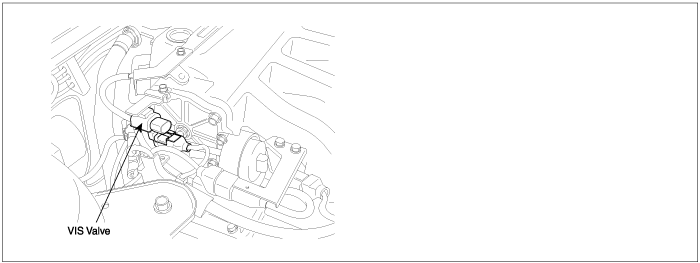
VIS(Variable intake system) is a device which varies the length of intake manifold to genetate maximum power at certain RPM. VIS lengthens intake manifold to improve the torque at low RPM when vehicle speed is low while it shortens intake manifold to raise torque at high RPM when vehicle speed is hign. PCU controlls VIS using RPM signal.
Checking the output voltage from VIS every 10 sec. under detecting condition, if the value within detecting condition lasts for more than 5 sec., PCM sets P0660. MIL(Malfunction Indication Lamp) turns on when the malfunction lasts till consecutive 2 driving cycle.
Item | Detecting Condition | Possible Cause | ||||||
DTC Strategy | ● Signal low, high | ● Poor connection ● Open or short in VIS circuit ● Faulty VIS ● Faulty PCM | ||||||
Enable condition | ● After 0.5 sec under conditions below ● Engine works ● 11V ≤ Battery voltage ≤ 16V | |||||||
Threshold value | ● Open or short | |||||||
Diagnosis time | ● Continuous (More than 5 seconds failure for every 10 seconds test) | |||||||
MIL ON condition | ● 2 driving cycles | |||||||
Item | Specification |
Coil Resistance (Ω) | 21.8 ~ 28.5Ω[22℃ (71.6℉)] |
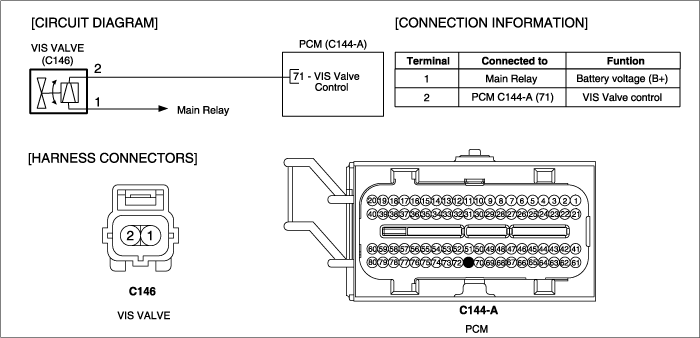
IG "OFF" & connect scantool.
ENG "ON" and warm -up the engine to normal operating temperature.
Monitor "VIS 1" item on the service data.

Is the related current data displayed correctly ?

▶ Fault is intermittent caused by poor contact in Sensor’s and/or PCM’s connector or was repairedand PCM memory was not cleared. Thoroughly check connectors for looseness, poor connection,bending, corrosion, contamination, deterioration, or damage. Repair or replace as necessary and goto "Verification of Vehicle Repair" procedure

▶ Go to "Terminal and Connector Inspection" procedure.
Many malfunctions in the electrical system are caused by poor harness and terminals. Faults can also be caused by interference from other electrical systems, and mechanical or chemical damage.
Thoroughly check connectors for looseness, poor connection, bending, corrosion, contamination, deterioration, or damage.
Has a problem been found?

▶ Repair as necessary and go to "Verification of Vehicle Repair" procedure

▶ Go to "Power Circuit Inspection" procedure.
IG "OFF" and disconnect VIS connector.
IG "ON" and ENG "OFF"
Measure voltage between terminal 1 of VIS harness connector and chassis ground.
Specification : Approx. B+
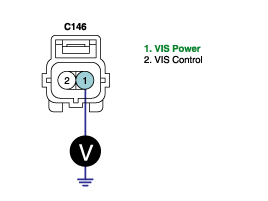
Is the measured voltage within specification?

▶ Go to "Control Circuit Inspection" procedure.

▶ Check fuse connected to power of VIS for open or blown-off.
▶ Repair open or short to ground in harness, and go to "Verification of Vehicle Repair" procedure.
Check voltage
IG "OFF" and disconnect VIS connector.
IG "ON" and ENG "OFF"
Measure voltage between terminal 2 of VIS harness connector and chassis ground.
Specification : Approx. 2.5V
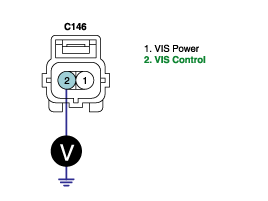
Is the measured voltage within specification?

▶ Go to "Component Inspection" procedure.

▶ Go to "Check short in harness" as follows.
Check short in harness
IG "OFF" and disconnect VIS connector and PCM connector.
Measure resistance between terminal 2 of VIS harness connector and chassis ground.
Measure resistance between terminals 1 and 2 of VIS harness connector.
Specification : Infinite

Is the measured resistance within specification?

▶ Go to "Check open in harness" as follows.

▶ Repair short in harness, and go to "Verification of Vehicle Repair" procedure.
Check open in harness
IG "OFF" and disconnect VIS connector and PCM connector.
Measure resistance between terminal 2 of VIS harness connector and terminal 71 of PCM harness connector.
Specification : Below 1Ω
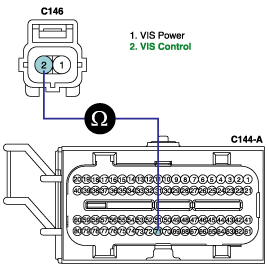
Is the measured resistance within specification?

▶ Go to "Component Inspection" procedure.

▶ Repair open in harness, and go to "Verification of Vehicle Repair" procedure.
Check VIS
IG "OFF" and disconnect VIS connector.
Measure resistance between terminals 1 and 2 of VIS connector.(Component side)
Specification : 21.8 ~ 28.5 Ω [22℃(71.6℉)]
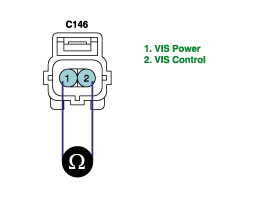
Is the measured resistance within specification?

▶ Substitute with a known - good PCM and check for proper operation. If the problem is corrected, replace PCM and go to "Verification of Vehicle Repair" procedure.

▶ Substitute with a known - good VIS and check for proper operation. If the problem is corrected, replace VIS and go to "Verification of Vehicle Repair" procedure.
There is a memory reset function on scantool that can erase optional parts automatically detected and memorized by PCM. After testing PCM on the vehicle, use this function to reuse the PCM on the others
After a repair, it is essential to verify that the fault has been corrected.
Monitor and record the Freeze Frame Data for the Diagnostic Trouble Code(DTC) which has been diagnosed.
Using a Scantool, Clear the DTCs
Operate the vehicle within conditions noted in the freeze frame data or enable conditions
Monitor that all rediness test have been verified as " Complete "
Are any DTCs present ?

▶ Go to the applicable troubleshoooting procedure.

▶ System is performing to specification at this time.